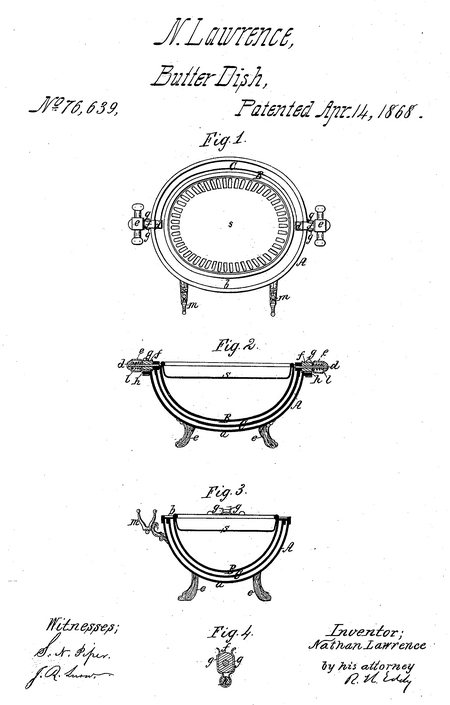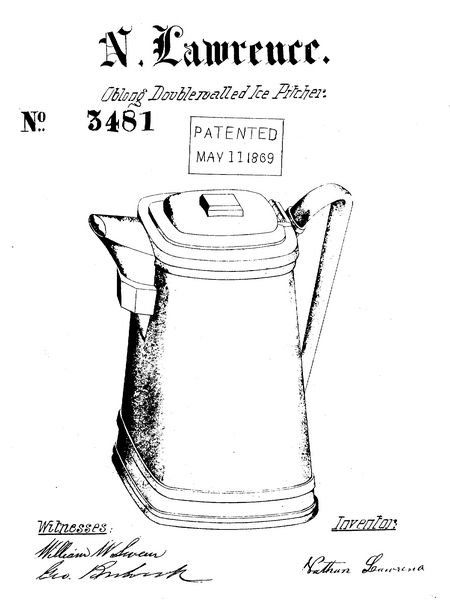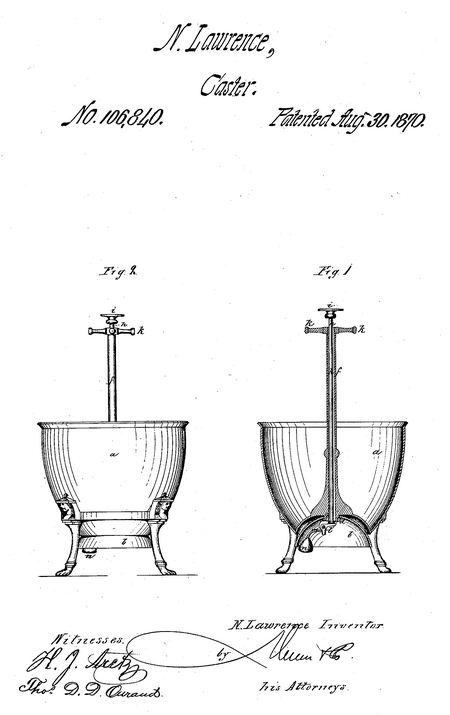Nathan Lawrence
- Born: 15 Feb 1822, Quincy MA
- Marriage (1): Adeline Maria Leach on 7 Oct 1847 in Dorchester MA
- Died: 5 Aug 1902, Taunton MA
General notes:
Pewtersmith and designer
Events in his life were:
- He worked circa 1840-1847 as a pewtersmith in Baltimore MD
- He worked in 1847-1896 as a foreman of britannia manufacturing in Taunton MA for REED & BARTON. At the death of Barton in 1867, he was promoted to superintendent of all factory work.
- He appeared on the census in 1850 in Taunton MA. Listed as a britannia metalsmith.
- He appeared on the census in 1860 in Taunton MA. Listed as a britannia worker.

- He was issued patent number 71,889 on 10 Dec 1867
NATHAN LAWRENCE, OF TAUNTON, MASSACHUSETTS, ASSIGNOR TO REED AND BARTON, OF SAME PLACE.
Letters Patent No. 71,889, dated December 10, 1867. IMPROVED BUTTER-DISH.
TO ALL PERSONS TO WHOM THESE PRESENTS MAY COME:
Be it known that I, Nathan Lawrence, of Taunton, of the county of Bristol, of the State (if Massachusetts, have made a new and useful Improvement in Butter-Dishes having semi-spherical rotary covers; and do hereby declare the same to be fully described in the following specification, and represented in the accompanying drawings, of which—
Figure 1 is a top view, and
Figures 2 and 3 vertical and transverse sections of a butter-dish provided with my invention.
In the drawings, A denotes a vase, having a semi-spherical body, a, containing a semi-spherical and concentric cup, B, the two being connected at their edges by a portion, 5, of an annulus. A strainer, s, for supporting the butter, is placed within the cup B. This butter-dish, so made and supported by a foot, c, is provided with a rotary semi-spherical hollow cover, 0, from opposite sides of which two journals, dd, extend in opposite directions, they being arranged so that their axes are one hundred and eighty degrees, apart. Consequently such journals are in one straight line running diametrically through the cover. Each of such journals terminates in a head, o, provided with two wings, e e, and runs through a box or bearing, f, going entirely around the journal. The two bearings, ff, are supported in sockets or ears, g g, extending from the vase A, each bearing being provided with lips, h, to keep it from moving endwise in its socket. It is kept in the socket by a pin, i, going through it and the walls of the socket. Within each head, o, is a chamber, k, to receive a helical spring, I, which encompasses the journal and bears against the outer end of the bearing f and the outer end of the chamber h, such spring serving as a means of producing friction to hold the cover in any position, whether wholly or partially, over the butter-dish.
As ordinarily made, such butter-vases or dishes have their journals supported in boxes, which are stationary or immovable as respects the outer shell or vase, the said boxes being provided with movable caps. I prefer to make each box in one block or piece, movable with respect to the vase, and with one end on the journal, because when so made there is no danger of losing the cap off the box or journal; and, furthermore, I combine with such box and its journal the friction-spring to operate as explained. This friction-spring prevents the cover from suddenly falling back from over the vase, as it is apt to do in depositing or moving the base on a table or otherwise.
I claim, therefore, the arrangement and combination of the friction-spring with the cover and vase, the journal and the bearing to extend entirely around the said journal, as specified.
NATHAN LAWRENCE
Witnesses:
William W. Swan
Joseph H. Rines

- He was issued patent number 76,639 on 14 Apr 1868
NATHAN LAWRENCE, OF TAUNTON, MASSACHUSETTS, ASSIGNOR TO REED AND BARTON, OF SAME PLACE.
Letters Patent No. 76,639, dated April 14, 1868.
IMPROVED BUTTER-DISH
TO ALL PERSONS TO WHOM THESE PRESENTS MAY COME:
Be it known that I, Nathan Lawrence, of Taunton, of the county of Bristol, and State of Massachusetts, have made an invention of a new and useful Improvement in Butter-Dishes having rotary covers; and I do hereby declare the same to be fully described in the following specification, and represented in the accompanying drawings, of which—
Figure 1 is a top view of a butter-dish with its cover down, such dish being provided with my improvement.
Figure 2 is a longitudinal section, and
Figure 8 a transverse section of it.
Figure 4 is a transverse section taken through one-of the spring-clasps or latches for supporting the boxes or bearings of the journals of the rotary cover.
The butter-dish on which my present invention is an improvement, is described in Letters Patent, No. 71,889, granted December 10, 1867, to Reed and Barton, assignees of myself, the inventor of the subject of such patent.
The boxes of the journals of the cover of the said butter-dish were held in their, sockets by means of pins, extending through-them and the. sockets, and connected to the dish by means of chains.
These pins are very liable to become detached from the vase or dish, and lost. The purpose, therefore, of my present improvement is to avoid the employment of such pins, and to use in lieu of them spring-latches, to support the box or bearing, clasp it on its opposite sides, and latch upon and hold it down or in place under ordinary circumstances. These latches admit of the easy removal of the box from them, but hold them with more than sufficient tenacity to enable the whole, dish, with whatever it may contain, to be readily lifted by its handles when the cover is up.
In the drawings, A denotes the vase, having a semi-ellipsoidal body, a, containing a semi-ellipsoidal concentric cup, B, the two. being connected at their edges by a portion, J, of an annulus. - A strainer, s, for supporting the butter, is placed within the cup B. The dish has four feet, c, projecting down from it, and it also has two furcated brackets, m m, extended from it, as represented, such brackets being for support of a knife to be used for cutting the butter.
The rotary cover, C, of the dish or vase is provided with two journals, d d, extending in opposite directions from it, and in the longer axis of it. Each of the journals terminates in a cross-head or handle, e, and runs through a box or bearing, f, which entirely encompasses the journal.
Each of these bearings, when in place, is supported between and by two spring-latches, g g, projecting from an ear, h, and formed in manner as represented in figs. 1 and 4. The latches, while holding the bearings in place with sufficient friction under ordinary circumstances, (that is, the covering and uncovering the vase, or lifting it by the handles of the cover and transferring it from place to place when the cover is up or out of the vase,) should be capable of yielding so as to enable the bearings to be raised from between them, (the said latches,) in order to allow of the removal of the cover from the vase for the purpose of cleaning either or both.
A friction-spring, I, placed in a chamber, made in the cross-head of the journal, bears against the end of the box or bearing, and, by so doing, serves to retain the cover in any position, whether it be either wholly or partially over the vase.
I do not claim, for supporting and holding the cover, journal-boxes in place, inflexible sockets and pins to go through them and the boxes, such being as represented and described in my patent as hereinbefore mentioned; but
I claim the combination and arrangement of the spring-latches g g with the vase, and for the purpose of receiving and holding the bearings or boxes of the journals of the cover, and admitting of their removal, in manner substantially as specified.
NATHAN LAWRENCE
Witnesses:
William W. Swan
G. Brabrook

- Patent: 3,375, on 16 Feb 1869. NATHAN LAWRENCE, OF TAUNTON, MASSACHUSETTS, ASSIGNOR TO REED AND BARTON, OF SAME PLACE.
Design No. 3,375, dated February 16, 1869.
DESIGN FOR AN ICE-PITCHER.
To all whom it may concern:
Be it known that I, Nathan Lawrence, of Taunton, in the county of Bristol, and State of Massachusetts, have originated a Design for a Double-Wall Ice-Pitcher, of which the following is a full, clear, and exact description, reference being had to the accompanying drawings, making part of this specification.
Figure 1 is a side view.
Figure 2, a plan.
This invention consists in the peculiar form of a double-wall ice-pitcher, hereinafter described, said form being given to the body of the pitcher alone, and being employed for ornamental purposes, and to distinguish ice-pitchers, of the inventor's manufacture, from all others.
The form which I thus employ, and which is clearly represented in figs. 1 and 2, is the oval or elliptical form; or, to speak more accurately, it consists in so constructing the body, A, of the pitcher, that if a horizontal section be taken through the same, at any point, said section will show two skeleton ellipses, one being the inner, and the other, the outer wall of the pitcher. At the same time, as seen in the plan, fig. 2, both the bottom, B, and the cover 0, are necessarily of a similar shape.
Having thus described my invention,
What I claim as new, and desire to secure by Letters Patent, is—
The design, of an oval shape, when applied to the body of a double-wall ice-pitcher.
NATHAN LAWRENCE
Witnesses:
W. W. Swan
Joseph H. Rotes

- Patent: 3,481, on 11 May 1869. NATHAN LAWRENCE, OF TAUNTON, MASSACHUSETTS.
Design No. 3,481, dated May 11, 1869.
DESIGN FOR AN ICE-PITCHER
To all whom it may concern :
Be it known that I, Nathan Lawrence, of Taunton, in the county of Bristol, and State of Massachusetts, have invented a new and useful Design for a Double-Wall Ice-Pitcher, of which the following is a full, clear, and exact description, reference being had to the accompanying drawings, making a part of this specification, in which the drawing is a perspective view.
This design contemplates a four-sided double-wall ice-pitcher, with rounded corners, two of the opposite sides being wider than the other two opposite sides, and the pitcher being thus oblong in cross-section. Having thus described my invention, What I claim as new, and desire to secure by Letters Patent, is—
The design of an oblong shape, when applied to the body of a double-wall ice-pitcher.
NATHAN LAWRENCE
Witnesses:
William W. Swan
George Brabrook

- He was issued patent number 91,754 on 22 Jun 1869
NATHAN LAWRENCE, OF TAUNTON, MASSACHUSETTS, ASSIGNOR TO REED AND BARTON, OF SAME PLACE.
Letters Patent No. 91,754, dated June 22, 1869.
IMPROVEMENT IN COFFEE-POT.
To all whom it may concern:
Be it known that I, Nathan Lawrence, of Taunton, in the county of Bristol, and State of Massachusetts, have invented a new and improved Tea and Coffee-Pot; and I do hereby declare that the following is a full, clear, and exact description of the construction and operation of the same, reference being had to the accompanying drawings, making a part of this specification, in which my invention is represented by a side view, a portion of the wall being broken away, and a portion of the handle being shown in section.
This invention relates to metallic tea and coffee-pots, and consists of an improved handle, which will not become so quickly heated as the handles heretofore made for such articles, together with an improved construction of the bottom, to prevent it from melting, and an improvement in the method of forming the body of the pot.
In the drawing—
A is the body of the coffee and teapot, provided with a handle, H, the latter being made rectangular in shape, and the outer portion thereof, which is grasped in lifting the pot, being provided with the vertical tubular passage h, from end to end.
This tubular construction not only diminishes the conduction of the heat, but allows the air to circulate freely through and cool the handle.
The pot is made of the common soft metals or alloys, in use for that purpose, and its side walls and bottom are struck up in a single piece, the bottom being concave on the under side, so that when set on a heated stove, only its rim shall come in contact with the same, and being provided with a series of corrugations, a a, concentric with it, for the purpose of increasing the surface, both outside and inside, and proportionately, its heat-conducting capacity.
Having thus formed the bottom, I attach around its rim, by any solder that will not yield readily to heat, a ring or shoe, r, of some hard, nearly infusible metal, or other refractory substance, on which the pot sits, and which alone comes in contact with the heated surface of the stove.
The spout and cover are then attached, and the outer surface of the walls is finished, plated, &c, after which the instrument is ready for use.
The refractory shoe or ring which I attach to the bottom of the pot, is not in the form of a flange extending downward from the edge of the vessel, but is simply a hard-metal ring, grooved or rebated around its inner surface, so as to form a socket into which the pot will fit nicely, as shown in the drawing, and attached after the rest of the pot is finished.
By this means I produce, at a comparatively slight expense, a handsome and durable coffee and teapot, which can be conveniently handled when rilled with boiling liquids, and the bottom of which will not melt down, although its rim is in contact with a very hot surface.
Having thus described my invention,
What I claim as new, and desire to secure by Letters Patent, is—
1. In a coffee or teapot made of the ordinary soft metal, fusible at low temperatures, the application of the ring r, of refractory material, when constructed in the form and attached in the manner described, and for the purpose set forth.
2. In a coffee or teapot, making the bottom concave on the under side, and providing it with a series of circular concentric corrugations, a a, as described, and for the purpose specified.
NATHAN LAWRENCE
Witnesses:
George Brabrook
Calvin P. Harris

- He was issued patent number 106,840 on 30 Aug 1870
NATHAN LAWRENCE, OF TAUNTON, MASSACHUSETTS.
Letters Patent No. 106,840, dated August 30, 1870.
IMPROVED CALL-BELL AND VESSEL.
To all whom it may concern :
Be it known that I, Nathan Lawrence, of Taunton, in the county of Bristol and State of Massachusetts, have invented a new and improved Combined Call-Bell and Vessel; and I. do hereby declare the following to he a full, clear, and exact description of the same, reference being had to the accompanying drawing making a part of this specification, in which—
Figure 1 is a sectional elevation, and
Figure 2 is a side elevation.
This invention relates to a vessel that may be used as a slop-bowl or sugar-bowl, from the bottom, of which a tube projects upward within the vessel, a stem being placed within said tube, extending above its top, passing through the bottom of the vessel, and furnished with a finger-piece at its upper end, outside the tube, the sounder of a call-bell being attached to the bottom of the vessel, while its tongue is hung between lugs that extend downward from the top of the sounder, in a position where it may be forced against the inside of the sounder by thrusting the said stem downward.
In the drawing—
a is the vessel, in the underside of which is a concavity, into which fits the sounder b of a call-bell, said sounder being kept in place by a nut, d, that is screwed upon the outside of a threaded tube, e, that extends downward from the bottom of the vessel through an orifice in the top of the sounder.
f is the tube that extends upward from the bottom: inside the vessel.
h is the stem that is placed within the tube f, and extends downward through the tube e.
i is a finger-disk on the top of the stem h.
k are arms projecting radially in a horizontal direction from the top of the tube f, which arms afford convenient bearings for the fingers in carrying the vessel about.
ll are lugs, projecting downward from the nut d.
m is an elbow, hung between the lugs I, with one of its arms just below the bottom of the stem h.
n is the tongue of the bell, attached to the other arm of the elbow m.
On pushing the stem ft downward it strikes the elbow m and drives the tongue n outward against the sounder.
Having thus described my invention,
What I claim as new, and desire to secure by Letters Patent, is—
The combination of vessel a, tube f, stem h, and sounder b, as specified.
NATHAN LAWRENCE
Witnesses:
F. L. Fish
William W. Swan
- He appeared on the census in 1870 in Taunton MA. Listed as a britannia worker.
Nathan married Adeline Maria Leach on 7 Oct 1847 in Dorchester MA. (Adeline Maria Leach was born on 30 Nov 1825 in Dorchester MA and died on 26 Feb 1915 in Taunton MA.)
|











